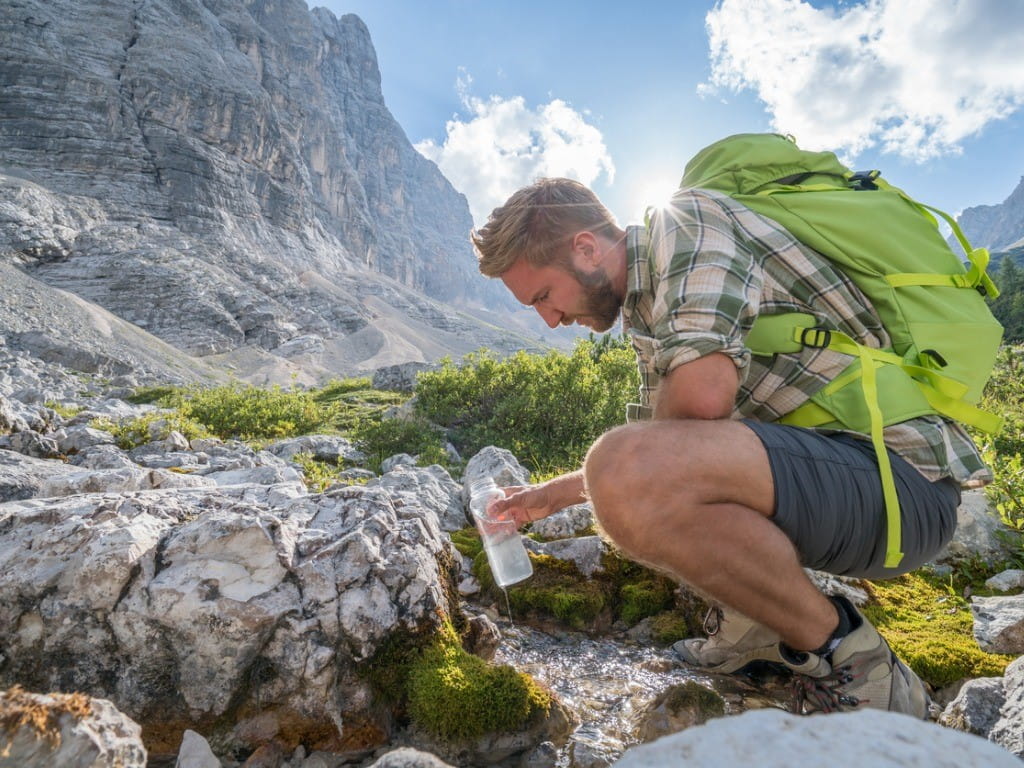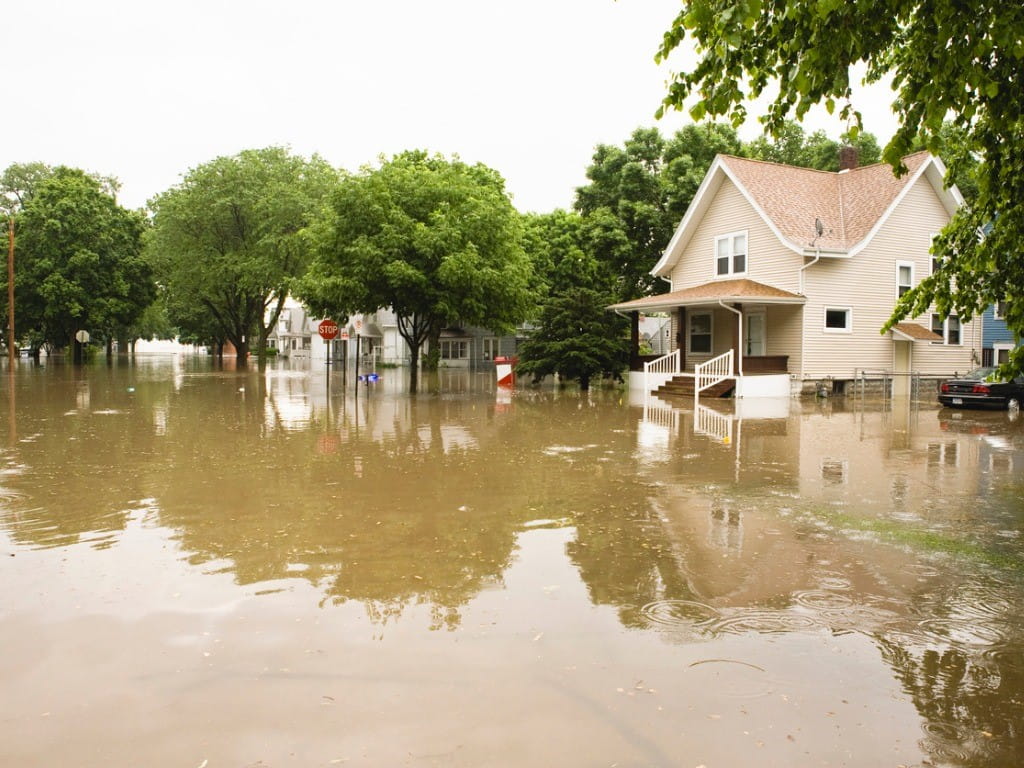Are Water Purifying Chemicals Safe?

The Bottom Line
Portable water purification chemicals are available in tablet, liquid, and powder form and contain the disinfectants iodine or chlorine. They can be added to untreated water to kill harmful microorganisms and make the water safer to drink. Although generally safe, they can easily be mistaken for medications or candy.

The Full Story
Perhaps you are an adventurer hiking in the wilderness and realize you are out of bottled water. There is a stream up ahead; you are quite thirsty and the water looks clean. Or perhaps your town was just hit hard by a hurricane, disrupting and contaminating your water supply. In situations like these, it is risky to drink untreated water. Portable water purifying products can come in handy and are marketed for use in these kinds of situations.
Drinking untreated water, which can contain various pathogens, can lead to illness ranging from mild gastrointestinal symptoms like nausea, vomiting, and diarrhea to more severe illnesses like hepatitis, meningitis, and even death. According to the Waterborne Disease and Outbreak Surveillance System (WBDOSS), in the United States during 2013-2014, 42 water-associated outbreaks were reported. These outbreaks resulted in at least 1006 cases of illness, 124 hospitalizations, and 13 deaths.
Water purifying chemicals can be added to untreated water to kill harmful microorganisms (protozoa, bacteria, and viruses) and make the water safer to drink. They can be useful following a natural disaster that disturbs the supply of drinkable water or for people who are camping, hiking, or find themselves in remote areas where safe drinking water is not readily available.
Water purifying chemicals available today are most commonly in the form of tablets, but they are also available in liquid drops or packaged powder. They contain either chlorine or iodine.
Whether liquid, tablets, or powder, water purifying chemicals are added directly to untreated water, releasing the chlorine or iodine. These disinfectants act directly on harmful organisms to destroy them. Water purifying chemicals vary in their shelf-life, length of time required for them to fully dissolve and be effective, and the concentration of the active ingredient. How well each chemical is able to destroy harmful pathogens and make untreated water truly safe to drink depends on multiple factors like the temperature, pH, cloudiness of the water, and how long the chemical is left to dissolve and fully take effect. It is important to note that not all pathogens will be completely eliminated by these chemicals. According to the Centers for Disease Control and Prevention (CDC), proper boiling of untreated water is the most effective technique, but this is often not practical. Furthermore, water purifying chemicals do not rid the water of chemical contaminants like pesticides.
How safe are water purifying chemicals and can they be poisonous? When used correctly, water purifying chemicals are generally safe. They themselves are a safety measure intended to be consumed, after all! However, when in tablet form, they can easily be mistaken for medications, vitamins, or candy, and children who gain access to them can swallow them.
Water purifying chemicals are quite irritating. When used inappropriately, excessively, or when swallowed whole, they lead to immediate irritation of the mouth, throat, and stomach causing symptoms such as burning and irritation in the mouth and throat, nausea, vomiting, and abdominal pain. Iodine-based water purifiers can lead to more severe, delayed and body-wide effects especially when used over a prolonged period of time. The risk of poisoning from water purifying chemicals depends on many different factors such as a patient's age and overall health and the amount and type of product swallowed.
Portable water purifying products have been around for many years and can be useful tools for reducing water-borne diseases. Unintentional ingestions of these products can occur because they look very similar to edible items. Keeping these products in their original packaging and separate from areas where food and medications are stored can help avoid unintentional exposures. Another important poison-prevention tip is to pay close attention to and follow the directions for each product; the chemicals' safety and effectiveness depend on it.
If you have any questions about water purifying products or if someone has been exposed to a water purifying chemical, check the webPOISONCONTROL® online tool or call Poison Control at 1-800-222-1222 for guidance.
Serkalem Mekonnen, RN, BSN, MPH
Certified Specialist in Poison Information
Certified Specialist in Poison information
Poisoned?
Call 1-800-222-1222 or
Prevention Tips
- Store water purification chemicals out of reach and sight of children, preferably in cabinets with child-resistant closures.
- Keep water purification chemicals in their original container and away from food or medicines.
- Use water purification products only as directed by the manufacturer and for their intended purpose.
This Really Happened
A 13-month-old boy opened a bottle of water purifying liquid containing chlorine dioxide. Relatives who were visiting from overseas had brought it with them. The boy's father was concerned that the boy might have swallowed some of it and called Poison Control for advice.
After interviewing the father, Poison Control determined that the boy would be able to tolerate the small amount he might have swallowed. Since chlorine dioxide is quite irritating, the father was advised to give the child fluids to drink and to monitor for nausea, vomiting, and signs of mouth or throat irritation. Fortunately, no symptoms developed.For More Information
References
Poisoned?
Call 1-800-222-1222 or
Prevention Tips
- Store water purification chemicals out of reach and sight of children, preferably in cabinets with child-resistant closures.
- Keep water purification chemicals in their original container and away from food or medicines.
- Use water purification products only as directed by the manufacturer and for their intended purpose.
This Really Happened
A 13-month-old boy opened a bottle of water purifying liquid containing chlorine dioxide. Relatives who were visiting from overseas had brought it with them. The boy's father was concerned that the boy might have swallowed some of it and called Poison Control for advice.
After interviewing the father, Poison Control determined that the boy would be able to tolerate the small amount he might have swallowed. Since chlorine dioxide is quite irritating, the father was advised to give the child fluids to drink and to monitor for nausea, vomiting, and signs of mouth or throat irritation. Fortunately, no symptoms developed.